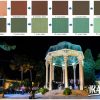In choosing materials of construction, we have to compromise between various factors. Use the acronym SHAMROCK to summarize and remember some of them.
S = Safety: what are the consequences of failure? If they are serious, a more resistant material than usual may be justified. For example, on a plant where leaking water would react violently with process materials, the water lines were made from a grade of steel resistant to stress corrosion cracking (from the chloride in the cooling water) as well as rust.
H = History: if a plant has used material successfully for many years, and the staff members know its strengths and limitations, how to weld it, etc., hesitate before making a change. For example, a fiberglass-reinforced plastic had given excellent service for many years; when another composite from the same company, with the same name but a different number, was used instead, it failed overnight.
A = Availability: before a salesman sells you the latest wonder-working material, ask how easy it will be to get replacement supplies in a hurry.
M = Maintenance: a plant engineer saved $10,000 per year by no longer neutralizing the slightly acidic cooling water. In time, rust formation in 30 jacketed reactors increased reaction times by 25%. I have known several engineers who gained a reputation for efficiency by similar measures, including neglecting maintenance, and then left their successors to pick up the tab.
R = Reparability: a plant bought some vessels with a new type of plastic lining instead of the one they had used for many years. The new material had better temperature resistance than the old, but when it did need repair, the patches would not stick. In time the problems were overcome, but reparability should have been considered before the change was made.
O = Oxidizing/reducing nature of process fluids: in acidic solutions, this affects the choice of alloys.
C = Cost: an important consideration, but look at lifetime costs, including maintenance, not just at initial costs.
K = Kinetics of corrosion mechanisms: unless we understand these, we will not know which materials will be suitable and which will not.
Taken (with minor changes) from: What Went Wrong? Trevor Kletz, Gulf Publishing





